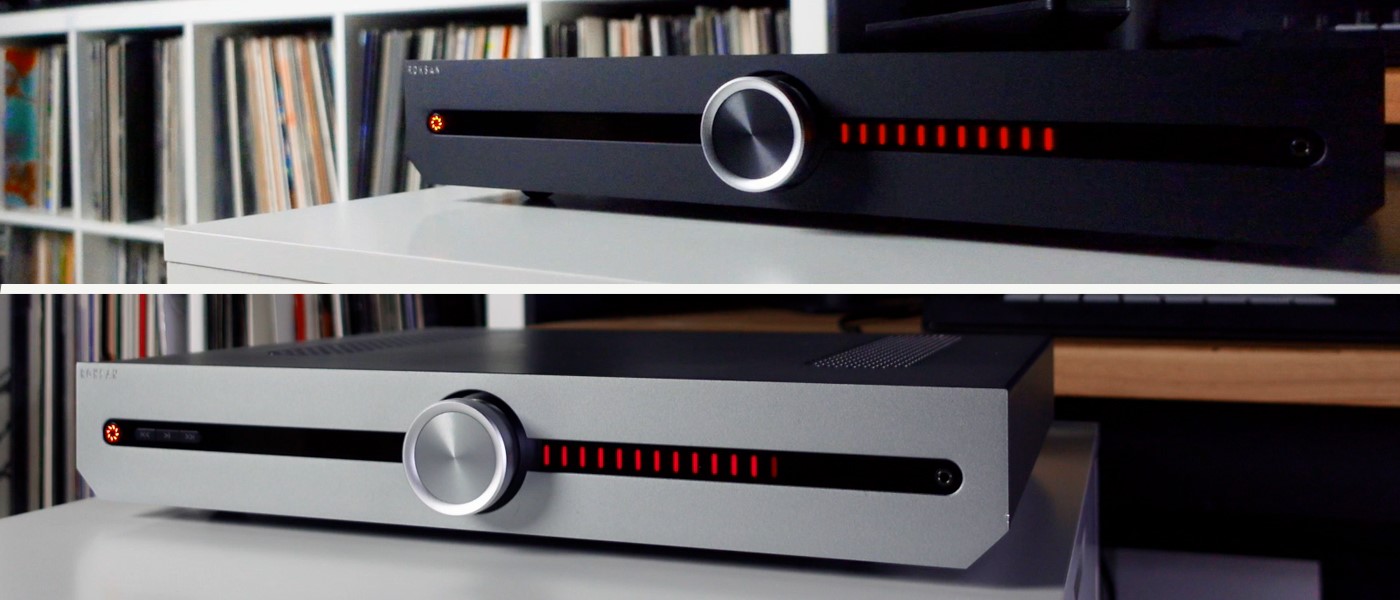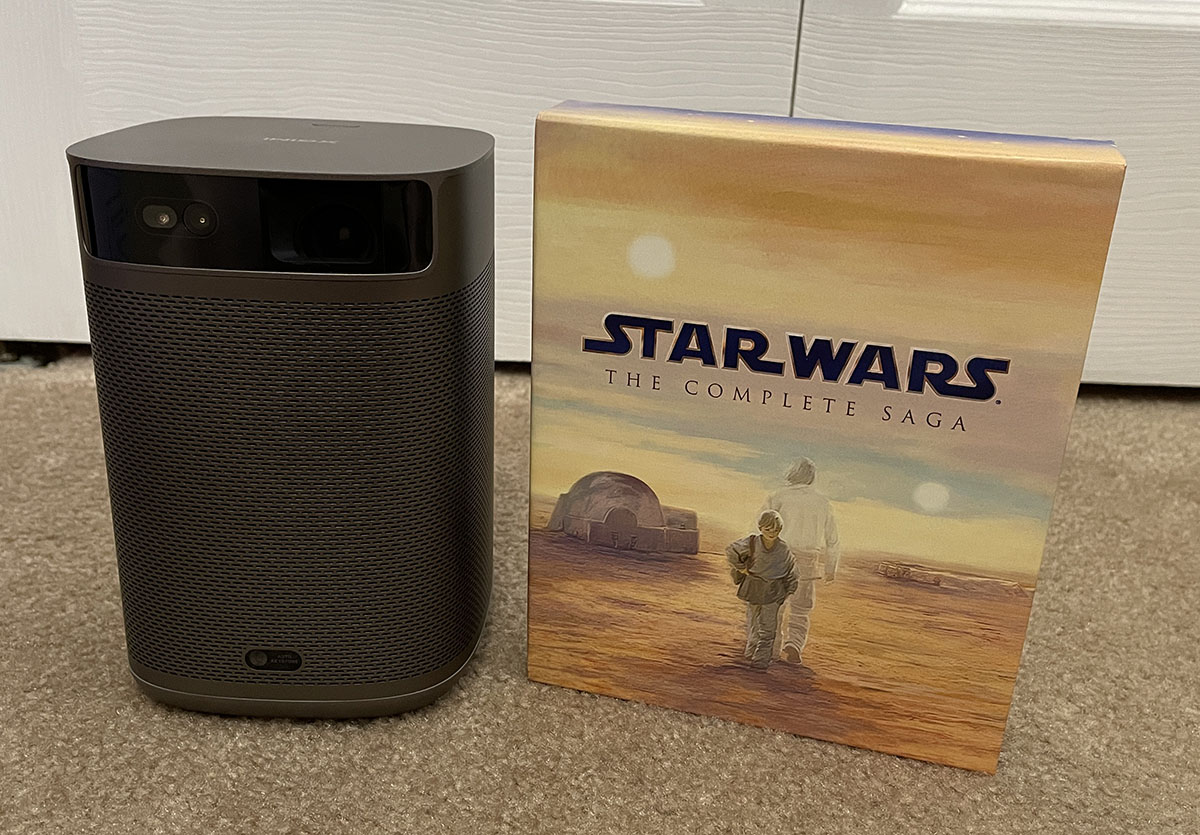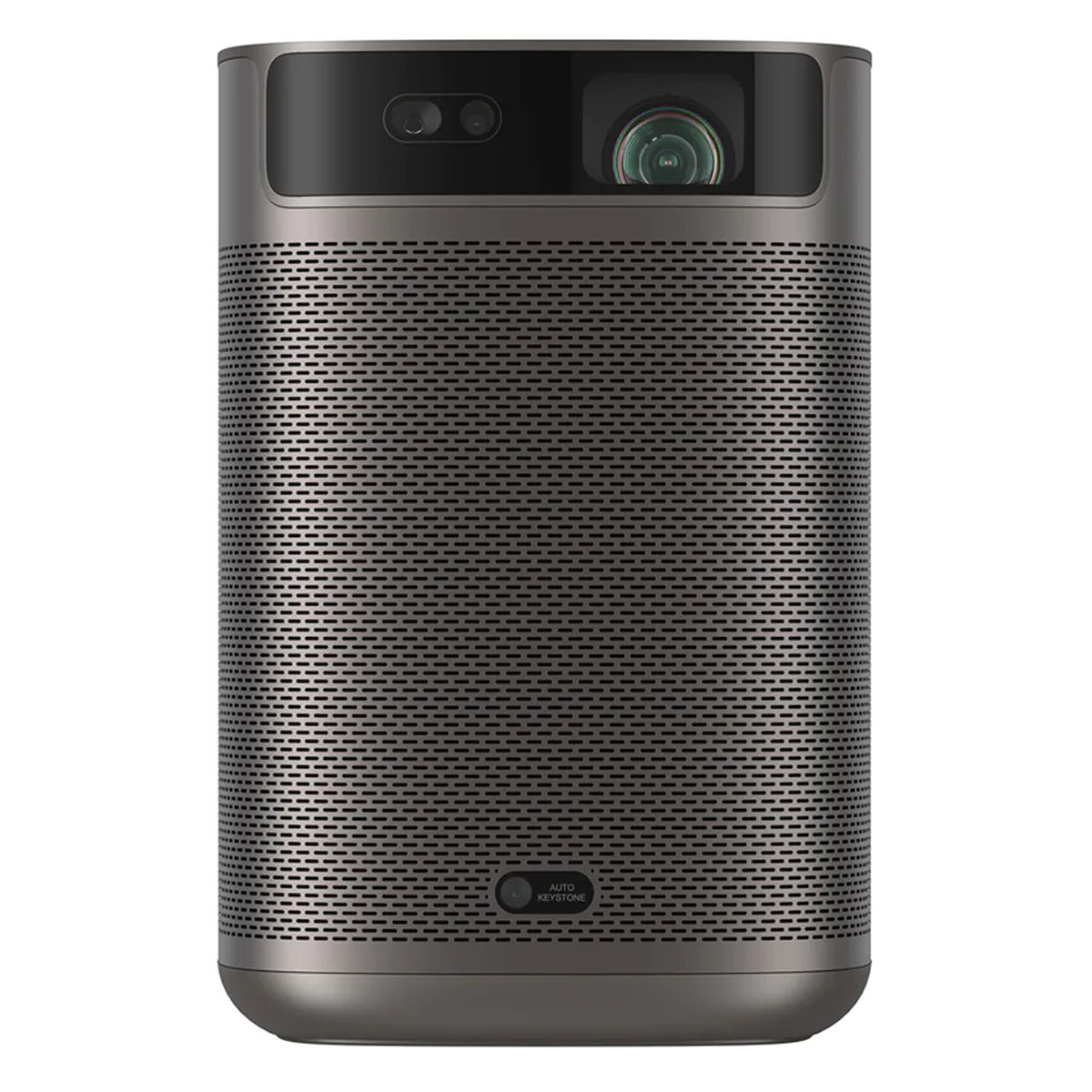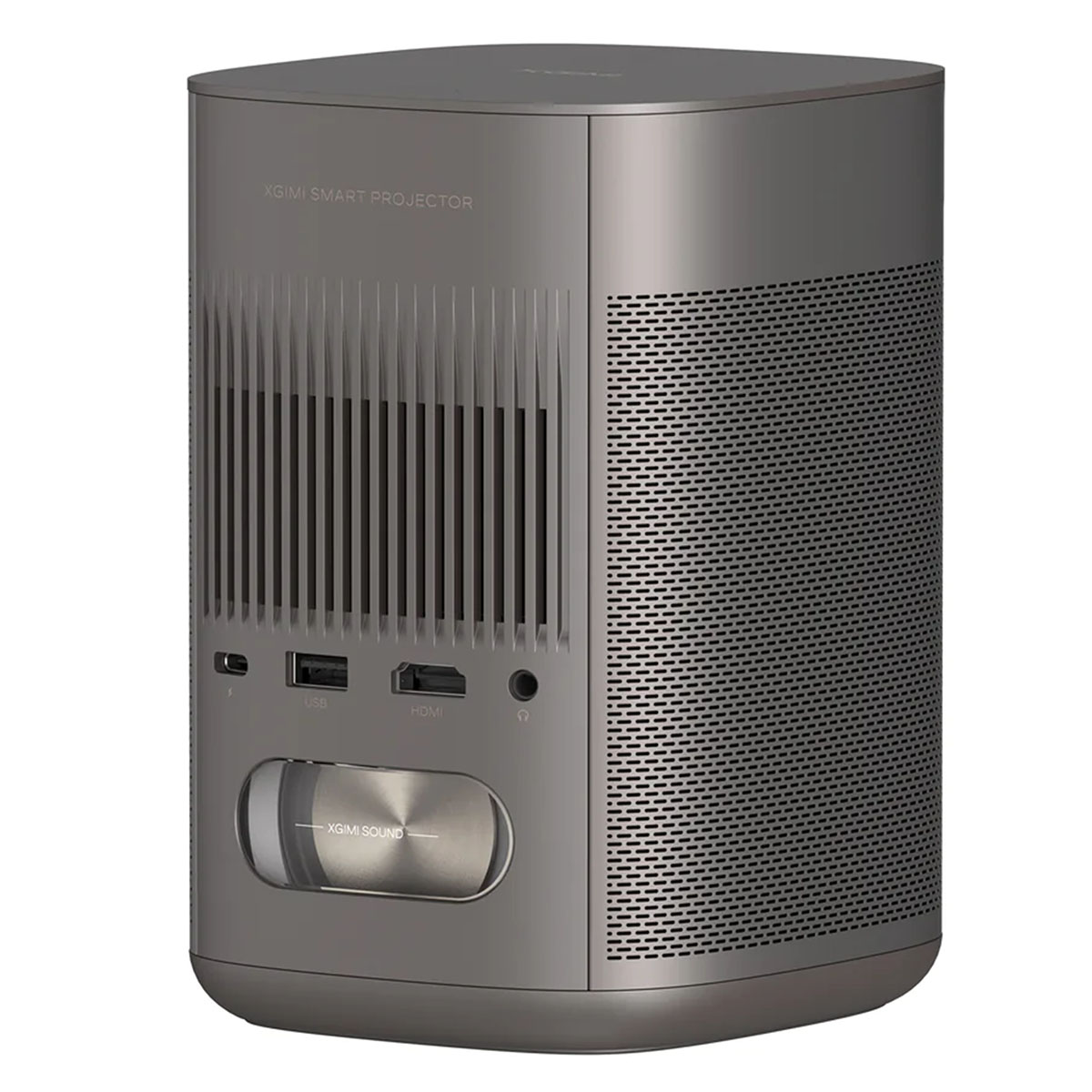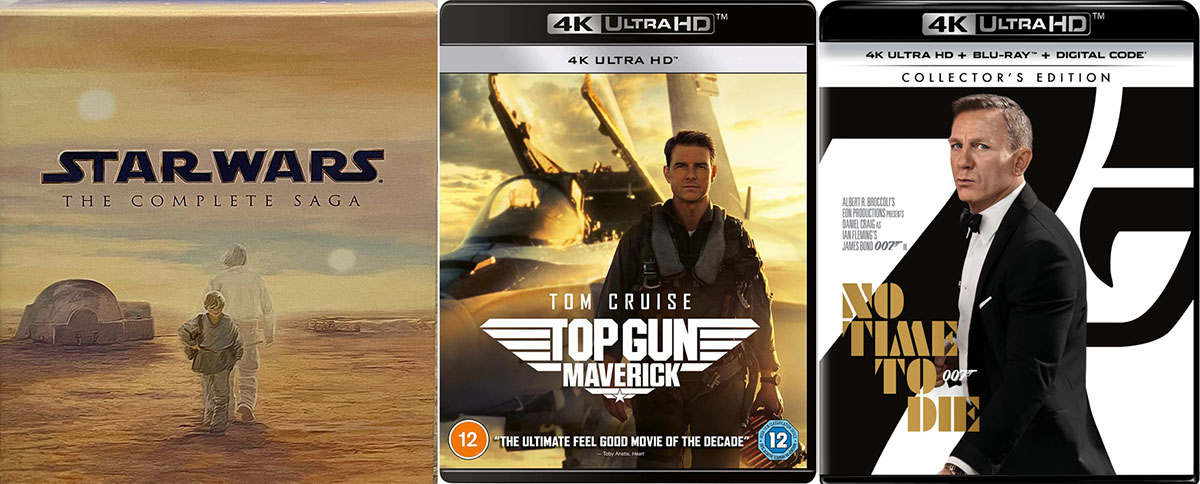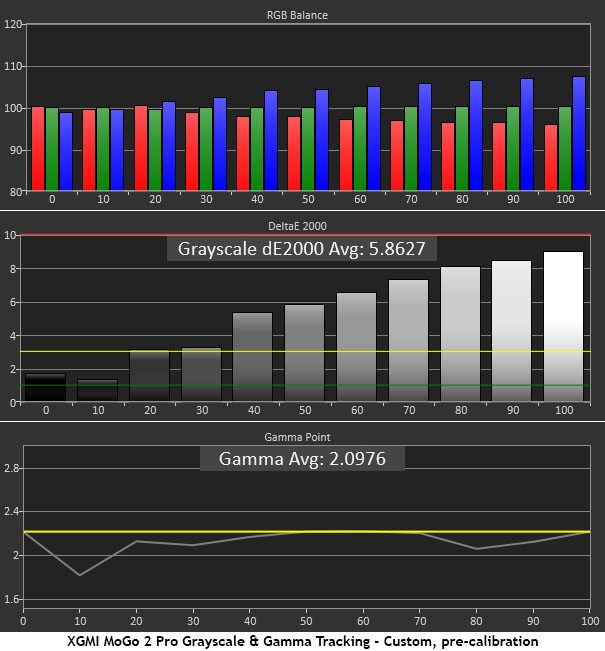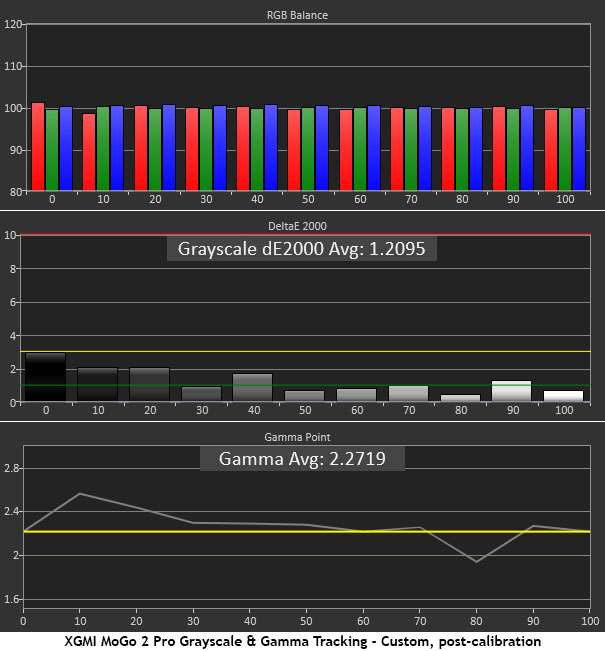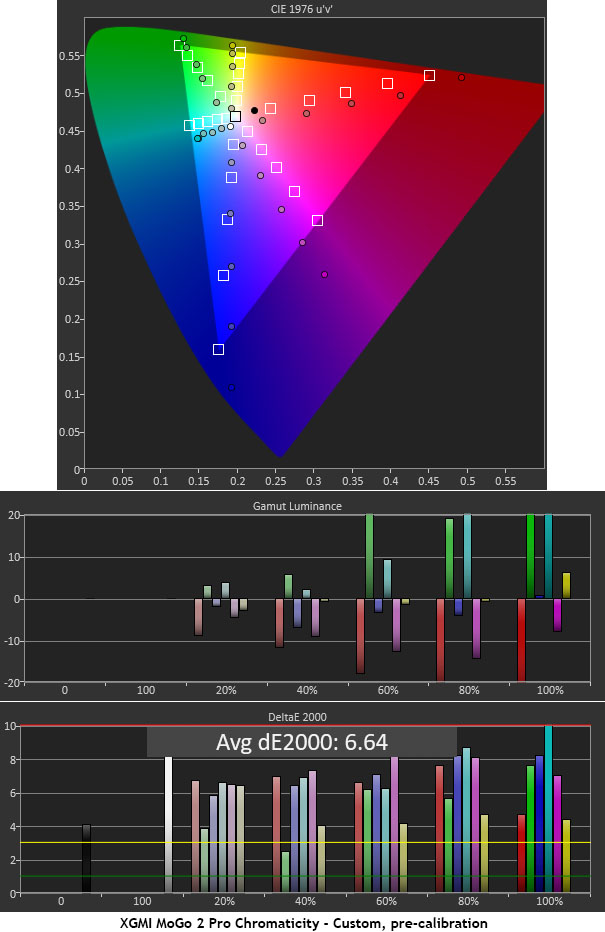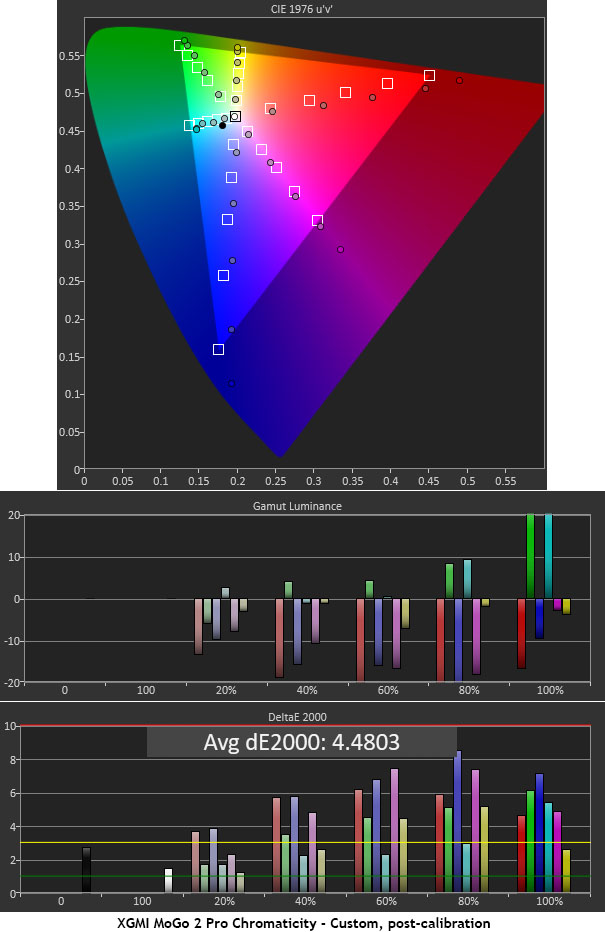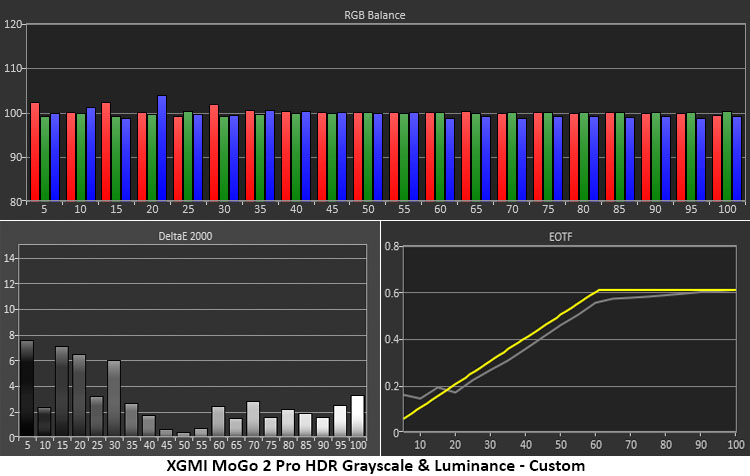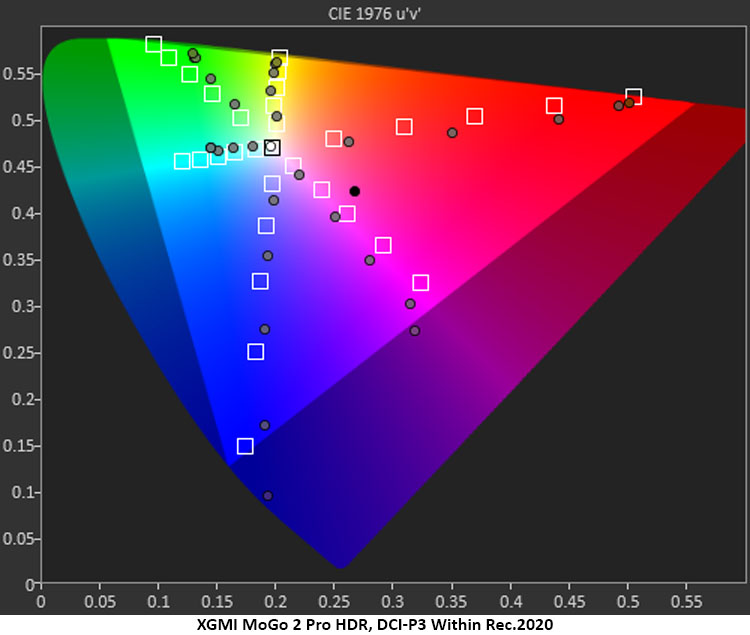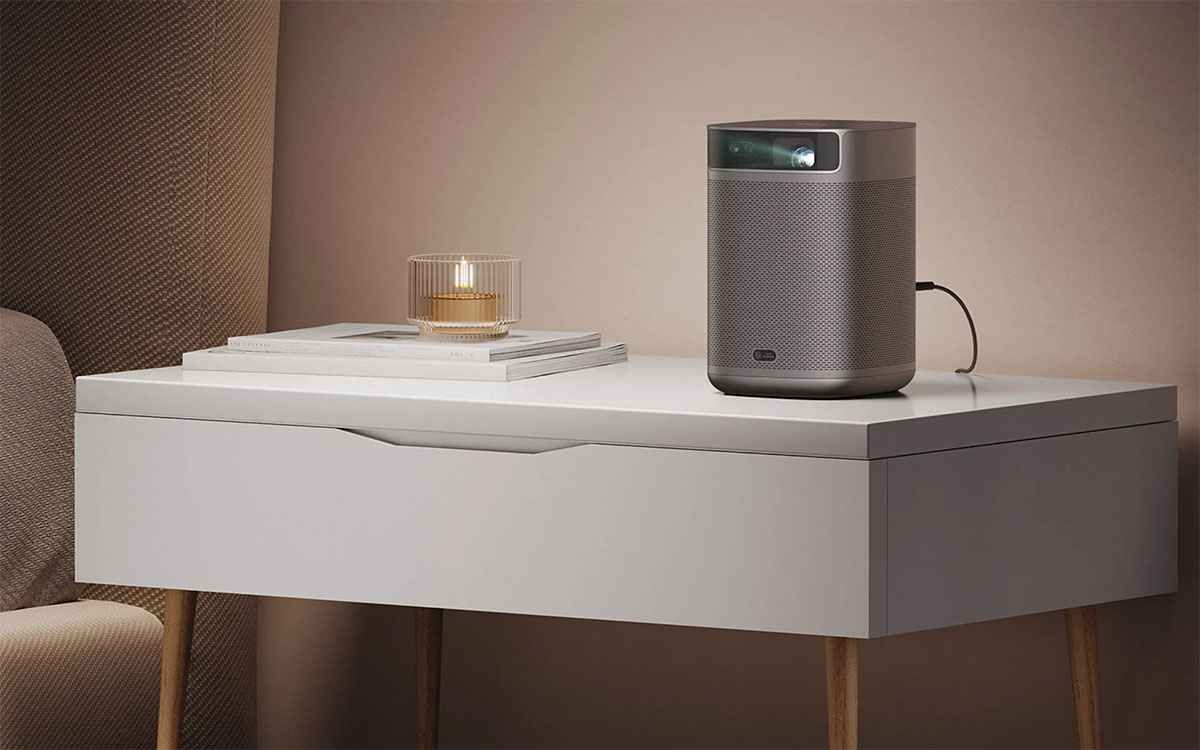The XGMI MoGo 2 Pro Portable Projector is a tiny display that renders 1080p resolution from a single-chip DLP with an LED light engine. It includes automatic keystone and focus correction so you can set it up anywhere and have a sharp picture within moments. Built-in speakers deliver surprisingly good sound, making the MoGo 2 Pro a fun way to enjoy movies anywhere there’s a white wall.
XGMI MoGo 2 Pro Portable Projector Highlights
- Portable DLP projector with LED light engine.
- 25,000-hour service life.
- Two 8-watt speakers play loud and clear for surprisingly good sound.
- Can be run from a portable power bank of 65 watts or more.
- Autofocus and keystone correction for quick and easy setup.
- HDR10 and 3D support.
The newest portable projectors have gotten incredibly small. I was impressed when they were about the size of a football but my latest review subject, XGMI’s MoGo 2 Pro, is about the size of a Bluetooth speaker, a small Bluetooth speaker. How is this possible? Through the magic of LEDs. Using a single-chip DLP and an LED light engine, the MoGo 2 Pro is not only tiny but also whisper-quiet.
Though the chassis is tiny, XGMI has managed to pack in two eight-watt speakers and a passive bass radiator. Thanks to some clever engineering, they sound amazingly large. You also get support for HDR10 and 3D content. Android TV is built in too, as is Wi-Fi, so you can run the MoGo 2 Pro without an external video source. It’s bright enough for dimly lit or dark spaces and can fill a screen, or wall, with an image up to 200 inches diagonal. Setup is quick and easy with auto focus and keystone correction. And the best part is you can add one to your gadget bag for just $599. Let’s take a look.
Type:
1-chip 0.23” DLP
Native resolution:
1920×1080
HDR:
HDR10
3D:
Top/bottom, side/side, DLP Link glasses (not included)
Light source:
LED
Service life (mfr):
25,000 hours
Light output (mfr):
400 ISO lumens
Throw ratio:
1.2x w/digital zoom
Lens shift:
No
Image size:
40-200 inches
Video connections:
1x HDMI 2.0 (accepts 4K/60p)
Additional connections:
USB-C, USB-A, 3.5mm audio output
Wireless:
Wi-Fi (2.4/5GHz, 802.11a/b/g/n/ac), Bluetooth 5.0
Audio:
2x 8-watt speakers, passive radiator
Dimensions:
6.33” × 4.68” × 4.25” (H x W x D)
Weight:
2.42lbs
Warranty:
1 year
MSRP:
$599
Website:
SECRETS Tags:
xgmi, mogo 2 pro, portable projector, dlp projector, led projector
Were it not for the lens peeking out from a black band on one side, the MoGo 2 Pro would look to anyone like a Bluetooth speaker. And it is indeed that, except with a projector built-in. At just over four inches square and a little more than six inches tall, it is officially the smallest projector I’ve ever reviewed. But don’t be fooled, it throws an image up to 200 inches diagonal and puts out a decent amount of light, as long as your room is dark.
Inside, there’s a single 0.23” DMD device (DLP) powered by an LED light engine. These used to be the stuff of high-end displays but no more. With common availability, LEDs are quickly replacing the large, hot, and short-lived lamps of the past. The MoGo 2 Pro is rated for 400 lumens and in my testing, I measured a 92” image at around 50 nits, give or take, sitting 10 feet back from a 1.3 gain screen. This is roughly equal to a flat-panel TV that’s been set up for dark room viewing.
Native resolution is 1920×1080, but the MoGo 2 Pro will accept signals up to 3840×2160 at 60Hz. It also processes HDR10 though with no additional contrast. 3D content is supported as well but only in top/bottom and side/side formats. With a pair of DLP Link glasses, you can view 3D content, but it is fairly dim, even in a completely dark room. If you plan to watch 3D, it’s best to pick bright content like animation.
The lens is fixed but a digital zoom function is available in the menu. A white wall will work as a projection surface, but a dedicated screen works better. Both autofocus and auto keystone are provided and work well. I strongly recommend turning off any keystone correction as it reduces resolution. The autofocus can be set to tweak itself every time you turn the unit on. A sensor cuts the light if you walk in front of the projector to save your eyes from getting flashed.
Aside from the black band containing the lens and autofocus sensors, the chassis is finished in a medium gray and perforated all around. The two internal speakers fire out the sides and produce a wide soundstage with clear sound. They play reasonably loud without distortion, even if you max the volume. In the back, a passive bass radiator is visible, and it provides a little extra depth. Overall frequency response is even. If you sit at least two feet behind the MoGo 2 Pro, you’ll swear the sound is coming from up front. The virtual effect is very convincing. The projector also processes Dolby Digital+ from the single HDMI port or from streamed content.
Speaking of the internet, XGMI has included Android TV and Chromecast capability. The interface is fully integrated and comes up whenever you turn the unit on. The only downside is that it takes a few extra steps to install Netflix, but most of the popular apps are there. With the MoGo 2 Pro’s dual-band Wi-Fi, you can pull in plenty of content without plugging in an external source component. For power, there is a USB-C port that accepts the included wall wart power supply, or a power bank battery rated for at least 65 watts. If you want to watch your movie silently, there’s a 3.5mm audio output for headphones.
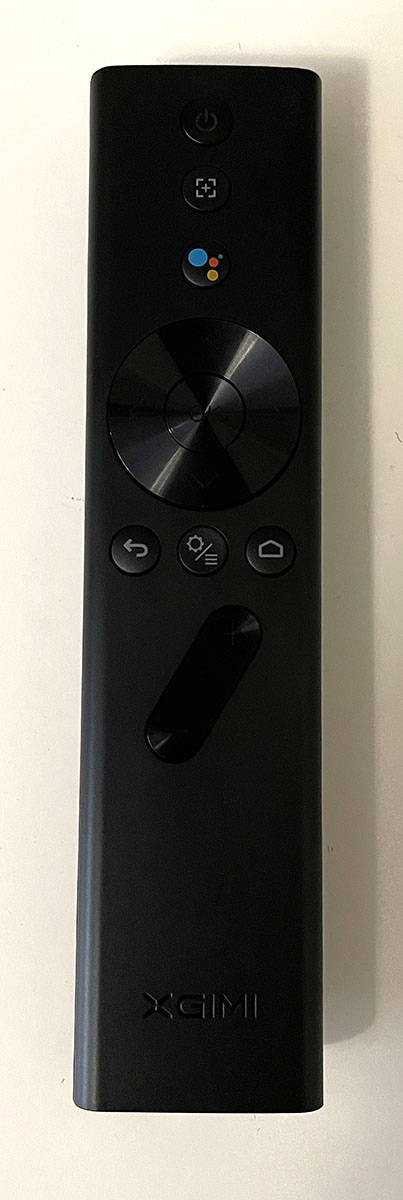
The MoGo 2 Pro includes a tiny remote that works intuitively to control both the projector and navigate the Android TV interface. It works via Bluetooth so there is no need for line of sight.
The MoGo 2 Pro can be plugged into the wall or powered by an external battery of 65 watts or more; I opted for the former. After pressing the single button on top, I was prompted to pair the remote which took only a few seconds. Then, I had to connect to Wi-Fi and set up Android TV. A Google login took care of that. To access the HDMI input, select the square/arrow icon at the top right. I connected a pattern generator for initial testing and calibration, then a Panasonic DP-UB9000 UHD Blu-ray Player, and an Apple TV.
Secrets Sponsor
The autofocus and auto keystone options are turned on by default. The autofocus, accessed by a dedicated button on the remote, works very well, especially if you have the room lights off first. The auto keystone also works fine but know that even the slightest correction will reduce resolution. This is clearly visible in both test patterns and actual content. A digital zoom option is available but to get the sharpest image, it’s best to physically move the projector closer to or farther from the screen. The throw ratio is 1.2 which means the image will be 1.2 times larger than the lens’ distance from the screen. Offset is ideal for placing the MoGo 2 Pro on a coffee table in front of the couch.
Calibration options are somewhat limited but achieving a reasonably accurate image is possible. The menu system is a bit scattered, but I found four picture modes, one of which offers a single-point white balance control. I was able to dial in grayscale tracking well but there are no gamma presets. It tracks relatively close to 2.2 with a few variations. More on that later. I also found five brightness modes. Of these, Bright and Vivid are the best choices. Performance should be avoided as it makes the image very green in tone and runs the internal fan at a high speed which is very loud. If you choose Custom, there are 10 settings. My advice – leave it on Vivid for the brightest possible picture.
The color gamut is larger than Rec.709 and cannot be changed. Red and blue are over-saturated, and you’ll see that in content though for the most part, the effect is a positive one. HDR10 material benefits from this extra color and though there is no extra contrast, the MoGo 2 Pro provides the proper tone mapping to give that content a little extra punch.

Hilary Hahn “the Schoenberg and Sibelius violin concertos”
The MoGo 2 Pro can function as a Bluetooth speaker and since it delivers excellent sound for its size, that’s how I started my hands-on evaluation. Once you’ve connected it to your phone or tablet, you can play music and watch a cool graphic of a spinning turntable on the screen or shut off the display. The sound stage is very wide, and the frequency response is nice and flat. There isn’t a ton of bass but what low end there is sounds clear and tight. I listened to Hilary Hahn play the Schoenberg and Sibelius violin concertos and was able to hear fine detail in both string and wind instruments along with her incredibly fluid technique.
Secrets Sponsor
As a movie machine, the MoGo 2 Pro does very well for its size and price. You can enjoy a blockbuster with its myriad of bombastic sound effects or a dialog-focused TV show. No matter what, the sound is well-detailed and spacious. I even noted some surround effects which was a pleasant surprise. As far as projector audio goes, I would rate only BenQ’s treVolo-equipped displays as equal to the XGMI.
With Star Wars Day coming up, it’ll have passed by the time you read this, May the Fourth Be With You; I sat down for a viewing of Episode IV, A New Hope. The picture was very clear with all the Blu-ray transfer’s information in plain view. I watched the 2011 HD release, no HDR or 4K conversion here. Flesh tones were natural with just a bit of ruddiness here and there. Red surfaces and buttons were very saturated but white and gray remained neutral. Like any DLP, brighter material looks best. The perceived contrast is high in scenes like the corridor battle at the beginning, or Imperial star destroyer flybys. Dark scenes are grayer in tone, but shadow detail is well rendered.
Top Gun Maverick is a great test for HDR displays with its deep blacks set against bright warm desert sunlight. I watched the dogfight scenes closely and was able to discern aircraft details in shadow areas while sunlit surfaces showed sandy textures. No part of the image was clipping which indicated the MoGo 2 Pro’s accurate HDR tone mapping. The color was a bit more natural than SDR because the native gamut, which is larger than Rec.709, is better suited for HDR.
No Time To Die has plenty of sunny content that looks great on the MoGo 2 Pro. The silver and chrome finish of Bond’s Aston Martin glistened as he evaded the bad guys through a series of yellow stone streets. Cuts to the car’s interior stayed true and I could clearly see the actor’s skin tones and the sweat dripping from Bond’s face.
Though I applaud XGMI for integrating Android TV so well into the MoGo 2 Pro, I prefer to use an Apple TV for streaming. Android still doesn’t directly support Netflix. You must install an app to access it and you don’t get 4K or HDR. And that’s a bummer because Netflix has the best audio and video quality of any streaming service, especially with its newest content like Formula 1 Drive to Survive. It’s a Dolby Vision title but here, it plays in HDR10. Contrast is solid in most areas except the interviews which are done against a blacked-out background. Blacks don’t get below a dark gray, but the MoGo 2 Pro is no different in that regard than any other DLP I’ve reviewed. There’s plenty of saturated color and the 50Hz framerate worked without issue.
I saw a similar quality in episodes of Chef’s Table. Close-up shots of food, done in slow motion, looked suitably appetizing with natural color and good depth in the bright foreground. Watching episodes of Michael Simon’s BBQ USA in 1080p SDR delivered nearly the same experience. The color was vivid but the over-saturated gamut did not create a cartoonish look. Though I’d prefer to see a Rec.709 option, its omission isn’t a big deal. I doubt anyone will complain about the MoGo 2 Pro’s color.
Overall impressions were that the MoGo 2 Pro does a decent job with HDR content. Even though there is no extra contrast, its correct rendering of the luminance curve gives the impression of greater image depth. The extra color enhances both SDR and HDR and the picture is always sharp. Brighter scenes look the best, especially in animated films. Dark areas aren’t truly black but as I said earlier, the MoGo 2 Pro is on par with other DLP projectors in that respect.
To test the MoGo 2 Pro, I set up my usual suite of benchmarks using the latest version of Calman from Portrait Displays. To measure color, I used an X-Rite i1 Pro Spectrophotometer, and for luminance, an X-Rite i1 Display Pro tri-stimulus colorimeter. Signals were generated by an Accupel DVG-5000. HDR signals were generated by the same unit with an HD Fury Integral in the signal path.
SDR Tests
The MoGo 2 Pro’s Custom picture mode allows grayscale calibration so that’s the one I chose for testing. The LED level was maxed using the Vivid brightness mode.
Pre-calibration grayscale runs cool though not in the extreme. Most users would be ok with what I observed. Gamma tracks close to 2.2 in the mid-tones, but shadow areas are very light. At this price point, I consider this to be very good out-of-box performance. It’s unlikely that anyone will spend $300 on a professional calibration for a $399 projector.
Adjusting the RGB controls made a positive impact that I could plainly see in actual content. Grayscale is now without visual error, but gamma has shifted somewhat. Shadow areas are now much darker, and this is a deliberate choice on my part. By lowering the brightness control, I improved perceived contrast significantly, but some fine shadow detail is clipped. I cannot account for the dip at 80% but it did not negatively affect actual content.
Here, you can see how the MoGo 2 Pro renders color for SDR content. On the cyan/green/yellow side of the gamut triangle, saturation is about right with just a little bonus green. Red, magenta, and blue are over-saturated. This can be seen in SDR material, but most users will appreciate the extra color even though it isn’t strictly correct. Since the saturation points track linearly, there is no loss of detail.
Though there are no gamut calibration options, color is vastly improved by the RGB adjustments. Hues are now much closer to their targets for all six colors. The over-saturation is still there but less obviously so. My observation of actual content is that these errors are forgivable given the MoGo 2 Pro’s low price.
HDR Tests
If HDR is set to auto in the menu, the MoGo 2 Pro will switch formats without user intervention when it senses an HDR10 signal. You can still access the picture modes and adjust grayscale, but the RGB settings are not independent for SDR and HDR.
When I applied an HDR10 signal, the MoGo 2 Pro switched automatically but I found my SDR RGB settings were still in play. Clearly, that isn’t a problem because HDR grayscale tracking is excellent. Aside from a few slight errors in the darkest steps, there are no visible issues here. Luminance tracking starts out a bit too light but at 20%, the levels get in line. In practice, HDR content appears to have more contrast thanks to accurate tone mapping.
The MoGo 2 Pro over-saturates red, blue, and magenta in HDR mode which adds punch to the image. Tracking is linear enough to prevent any detail loss except in the most saturated tones where the 80% points are very close to the 100% targets. This is typical performance for wide-gamut displays.
Brightness and Contrast
To measure the MoGo 2 Pro’s brightness, I set it up 10 feet from a 1.3 gain Stewart Filmscreen Luminesse with Studiotek 130 material. The room was completely dark and as I observed, this is the best way to enjoy the projector. Any ambient light will wash out the image. The LED was set to its maximum level.
SDR Brightness & Contrast
HDR Brightness & Contrast
3D Brightness & Contrast
There is no iris or LED modulation in play here. Measured contrast is about the same for SDR and HDR content but HDR looks better thanks to its accurate luminance tracking. 3D is very dim and only suitable for bright content.
Settings
At $599, nothing really competes with the XGMI MoGo 2 Pro Portable projector. It punches above its weight class in video and audio quality.
- Sharp image with vivid color
- Excellent audio quality
- Compact size with solid build quality
- Terrific value
- Rec.709 color option
- Better gamma tracking in SDR mode
At $599, it’s hard to find any real faults with the XGMI MoGo 2 Pro Portable Projector. For its size, it puts out enough light to create a jumbo image in a dark room or out by the pool at night. It’s built-in speakers and bass radiator provide enough sound to fill a small to medium-sized room and play with excellent clarity. The Android TV interface is well-integrated and pulls in a wealth of streaming content using the included Wi-Fi. And if you want to hook up a Blu-ray player or streaming box, an HDMI input is available. For true portability, you can toss a 65-watt power bank in your gadget bag and watch movies anywhere there’s a light-colored wall. And if you just want some music, the MoGo 2 Pro serves well as a Bluetooth speaker.
In the genre of portable displays, there isn’t much that can compete with the XGMI MoGo 2 Pro Portable Projector. Users looking for something to travel with should definitely check it out.


